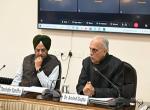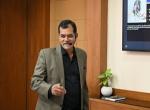On 27 September 2023, the VIF under its Science and Technology (S&T) series organized a talk by Dr Kumar Vaibhav Srivastava on “Metamaterials for Stealth Technology”. Dr Srivastava is currently Professor and Head, Department of Electrical Engineering, and Sanjay & Rachna Pradhan Chair Professor at the Indian Institute of Technology (IIT), Kanpur. His presentation focused on metamaterials for stealth technology that has military implications. The talk was chaired by Director, VIF, Dr Arvind Gupta, who in his opening remarks outlined the significance of metamaterials, especially in the field of defence. Dr Gupta said that under the S&T series, we are looking at various problems and trying to find out solutions to them, especially under the larger framework of building S&T ecosystem in the country.
The meta-materials are the next generation technology that is used mainly to control and manipulate electromagnetic fields and acoustic waves. The stealth technology is scientifically known as low observable technology. It is a branch of military tactics and basically used in military aviation. It deals with a variety of techniques for making people, vehicles, and mostly aircraft less visible to radar, infrared, and other detection technologies. Camouflage was the first technique to test the idea that an object may be made to disappear into its surroundings. They are only trying to reduce the reflection of objects. People are trying to integrate the stealth technology with Radar, Optical and Infrared. While Radar has become prominent because of its ability to detect objects from a distance of more than hundreds of kms.
In this context, Prof Srivastava in his talk highlighted some of the key technologies demonstrated by IIT, Kanpur on metamaterial stealth. Usually, the meta-material absorbers are narrow band in nature but the group at IIT, Kanpur has put dedicated efforts on enhancing the bandwidth of these absorbers. The developed absorbers provide good absorption in microwave frequency covering almost all Radar bands. They have also developed optically transparent microwave absorber which is one of its kind in world. Further, they have developed textile based microwave absorbers which could be helpful hiding ground based defence assets from Radar detection. This can be used as uniforms for soldiers and coverings for ground vehicles to avoid detection by enemy radar, motion-detecting ground sensors and thermal imaging systems.
In addition to uniforms for soldiers and cover for vehicles on the ground, the group at the IIT, Kanpur are also developing a more robust version of the metamaterial for high-speed fighter aircraft and “switchable metamaterials for active camouflage applications.” The Department of Science and Technology (DST) under the Defence Research Development Organisation (DRDO) has been supporting this indigenous development of stealth technologies. Moreover, one of the very critical technologies developed by them is reconfigurable meta-surface where the response of structure can be changed electronically.
The research group at the IIT, Kanpur is working on developing optically transparent microwave metamaterial absorbers. They have developed it for the aircraft canopy, which is made of glass surface. They have also developed Radar Absorbing Cloth that can be used for covering ground assets that need to be protected from Radar detection. However, there are challenges with current technology in absorptive metamaterial. For instance, with the use of this meta-surface on any object reduces its detectability by Radar. But at the same time object becomes blind in itself. The object below the absorbing surface cannot communicate with the outside world. Meta-surface requires transmission band to communicate with outside world. At the same time, it is also desired that object cannot be detected by the enemy Radar.
It was also pointed out that the ITO based coating had issues in the past. Because this was relevant only if the aircrafts or missiles are coming at the higher point that reduces radar signature. While those are flying below or on the ground, Radars are able to pick up. The Ukraine war has also shown that the missiles are getting shot down, where stealth technology further needs to be developed so that the enemy cannot detect objects during contingency situations. These are some of the concerns that need to be addressed.
It was observed that the solution to current technological challenge in absorptive metamaterial is to have absorption and transmission at the same time. There is need of multi-functional meta-surface. It was pointed out that the project for ITO based coating on canopies were languishing for over a decade because of lack of funding. It has now come up and will be useful in the defence field.
It was suggested that while the researchers and scientists working on such projects, they need to be in touch with the practitioners or users of these technologies right from the inception so that they can meet the requirements and address any issues relating to the technologies. In this context, the continued interaction between the academics, DRDO and the defence services would be critical in future technology development. Moreover, the government funding and practical applicability of technologies are also very significant.









Post new comment